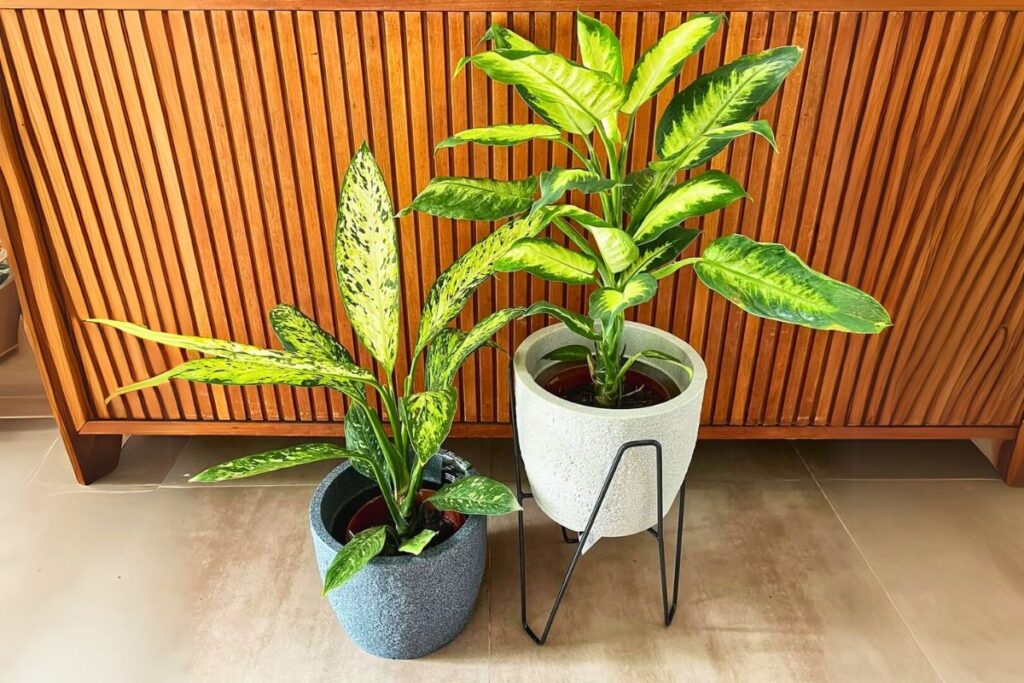Dieffenbachia, also known as dumb cane, is a popular houseplant admired for its striking foliage and easy-going nature. With its large, patterned leaves and robust growth, dieffenbachia can add a touch of tropical elegance to any indoor space. Whether you’re a seasoned plant enthusiast or a beginner, this guide will help you understand how to care for dieffenbachia plants indoors.

Contents
Choosing the Right Location
Dieffenbachia plants thrive in bright, indirect light. They can tolerate lower light conditions, but their growth and leaf coloration will be more vibrant with adequate light. Place your plant near a window where it can receive plenty of filtered sunlight. If natural light is limited, consider using a grow light to supplement its needs. Avoid direct sunlight, as it can scorch the leaves.
Maintaining Proper Temperature and Humidity
Dieffenbachia plants prefer warm and humid environments, similar to their native tropical habitat. Keep your plant in a room with temperatures ranging from 65-75°F (18-24°C). Avoid placing it near drafty windows or heating vents, as sudden temperature fluctuations can stress the plant. To maintain humidity, mist the leaves regularly or place a humidity tray with water and pebbles underneath the pot. A room humidifier can also help create a more suitable environment.
Watering Wisely
Proper watering is crucial for the health of your dieffenbachia plant. These plants prefer consistently moist soil, but they don’t tolerate waterlogged conditions. Water your dieffenbachia when the top inch of soil feels dry to the touch. Ensure the pot has drainage holes to prevent water from accumulating at the bottom. Overwatering can lead to root rot, so it’s better to err on the side of caution and avoid letting the soil become too soggy.
Soil and Fertilizing
Dieffenbachia plants thrive in well-draining, nutrient-rich soil. A mix of potting soil, peat moss, and perlite works well to provide the right balance of moisture retention and aeration. Feed your plant with a balanced, water-soluble fertilizer diluted to half strength every 4-6 weeks during the growing season. Reduce or stop fertilizing during the dormant period to prevent nutrient buildup.
Pruning and Maintenance
Regular pruning helps maintain the shape and health of your dieffenbachia plant. Remove any yellowing or dead leaves to encourage new growth and keep the plant looking its best. You can also trim back any leggy stems to promote a bushier appearance. Dieffenbachia plants can tolerate moderate pruning and will often respond with vigorous new growth.
Styling Your Dieffenbachia Plant
Dieffenbachia plants are versatile and can be styled in various ways to enhance your indoor decor. Here are some ideas to help you create a stunning display:
- Tall Floor Plant: Use a decorative pot and allow the plant to grow tall, making it a striking floor plant that adds vertical interest to your space.
- Tabletop Accent: For a more compact look, place the plant in a smaller pot and position it on a tabletop or desk. Its large, patterned leaves will add a touch of elegance to your workspace or living area.
- Grouping with Other Plants: Combine your dieffenbachia with other indoor plants to create a lush, green oasis. The contrasting textures and colors can add visual interest to your plant collection.
- Creative Containers: Choose pots and containers that complement your interior design. The contrast between the plant’s vibrant foliage and stylish pots can enhance the overall aesthetic.
Propagation Techniques
Propagating dieffenbachia plants is relatively easy and a great way to expand your collection or share with friends. Here are two common methods:
Stem Cuttings
- Choose a healthy stem with several leaves.
- Using clean scissors or pruning shears, cut a 4-6 inch section just below a node.
- Place the cutting in water or a well-draining potting mix. If using water, change it regularly to prevent stagnation.
- Once roots develop, transplant the cutting into soil.
Division
- Remove the plant from its pot and gently separate the root ball into smaller sections, ensuring each section has at least one healthy stem and root system.
- Plant each section in fresh, well-draining soil and water thoroughly.
Dealing with Pests and Diseases
Dieffenbachia plants can occasionally fall victim to pests such as spider mites, aphids, and mealybugs. Regularly inspect your plant for signs of pests and treat any infestations promptly with insecticidal soap or neem oil. Maintaining proper care practices and a clean environment can help prevent most common issues. Yellowing leaves can indicate overwatering or inadequate light, so adjust your care routine as needed.
Troubleshooting Common Issues
- Yellowing Leaves: Often a sign of overwatering or poor drainage. Check the soil moisture and ensure the pot has adequate drainage.
- Brown Leaf Tips: This can indicate low humidity or underwatering. Increase humidity levels and adjust your watering schedule.
- Leggy Growth: Lack of light can cause leggy growth. Move the plant to a brighter location or provide supplemental light.
Growing dieffenbachia plants indoors can be a rewarding experience, adding a touch of tropical beauty to your home. By following these care tips and paying attention to your plant’s needs, you’ll be well on your way to enjoying a lush and healthy dieffenbachia plant. Happy planting!
